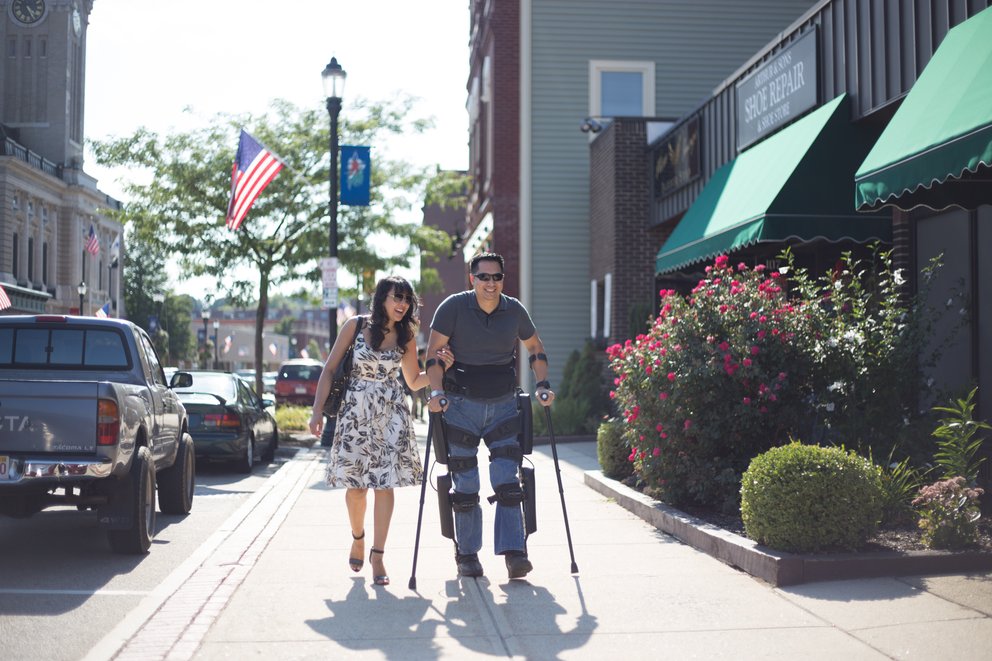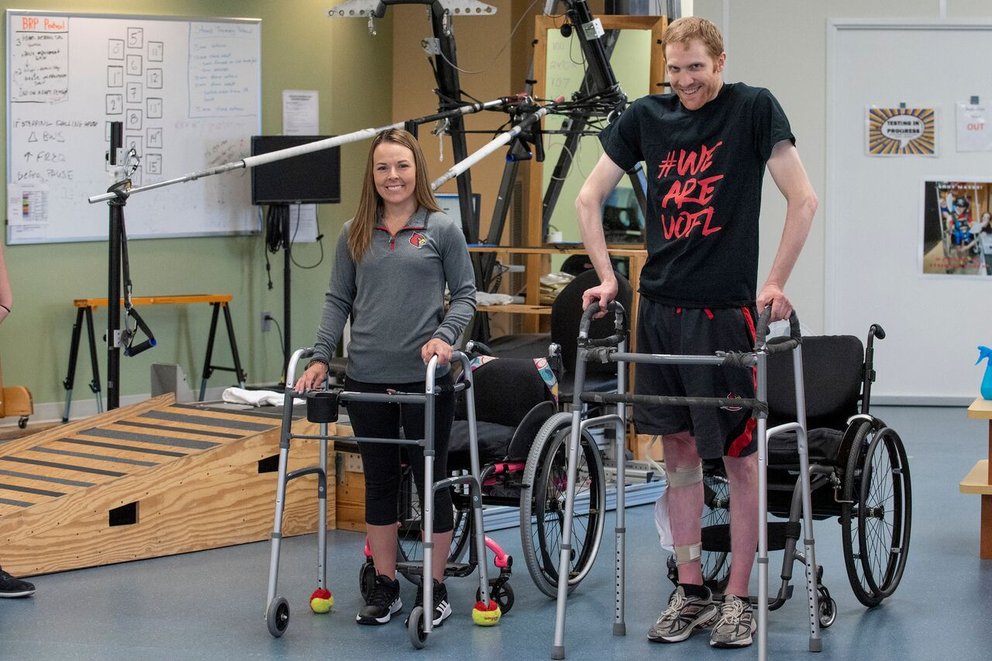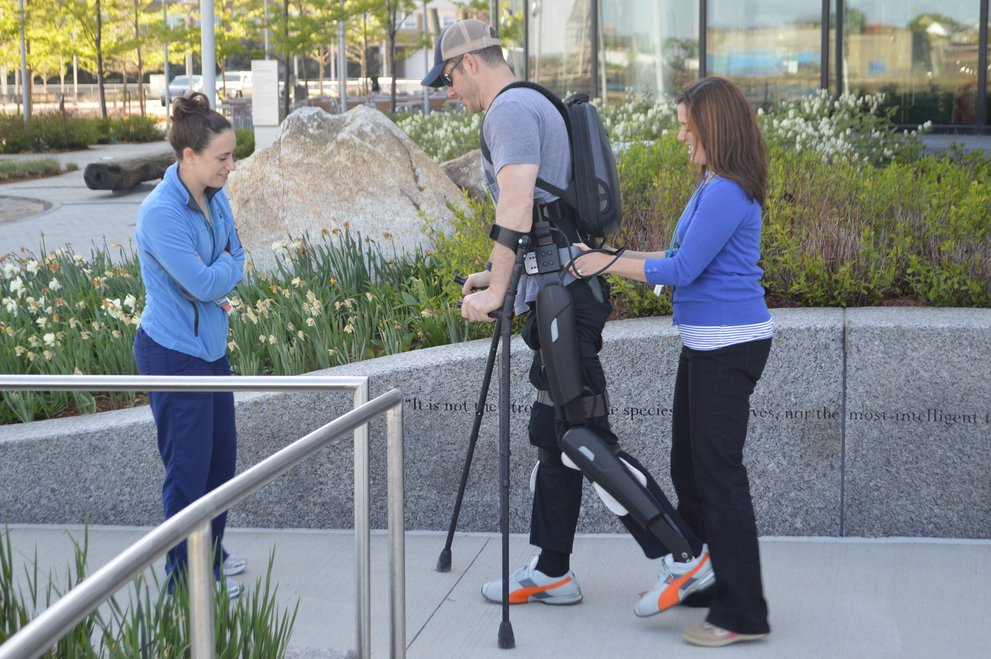
Jeff Marquis, a professional chef, loved nothing better than snowboarding, hiking, and mountain biking on the trails near his Montana home. Then, in 2011, catastrophe struck. Marquis, 29 at the time, was thrown from his bike. “I remember lying on the ground, realizing my hands weren’t working right and I couldn’t get up,” he says.
Marquis was told that a severe spinal cord injury meant he’d never stand or walk on his own again. But during rehabilitation, he learned about the efforts of researchers at the University of Louisville School of Medicine who were testing whether implanted electrical stimulators could help restore some movement for paralyzed patients. “I decided to go for it,” he recalls.
Five years later, Marquis stood on a specially designed treadmill at the university’s Kentucky Spinal Cord Injury Research Center and took his first tentative steps. Thanks to a revolutionary combination of targeted physical therapy and electrical stimulation of neurons in his spine, Marquis is now able to walk up to a quarter of a mile, using horizontal poles for balance.
“The image of a paralyzed person getting up and walking is almost biblical.”
Charles Liu, MD, PhD
Director, Neurorestoration Center
Keck School of Medicine of the University of Southern California
Marquis is among the estimated 1.2 million people in the United States who had little or no hope of walking after a spinal cord injury. Now, though, that grim prognosis is changing for the better. After decades of scant progress, researchers are making major advances in mechanical engineering, computer sciences, rehabilitation medicine, and neurobiology that have spawned a range of possibilities, from implantable devices like the one Marquis uses to Iron Man-like robotic exoskeletons.

“The image of a paralyzed person getting up and walking is almost biblical,” says Charles Liu, MD, PhD, director of the Neurorestoration Center at the Keck School of Medicine of the University of Southern California, where researchers are working on a sophisticated brain-machine interface. “But that’s what we’re seeing.”
“This isn’t a cure,” explains Liu, who is a neurosurgeon and bioengineer. “But we’re able to offer new hope to people who thought they would never be able to stand on their own or walk again.”
Robots to the rescue
The first major advance for paralyzed patients came in 2014, when the FDA approved ReWalk Robotics’ request to begin marketing a robotic exoskeleton. Since then, two other exoskeletons, Indego and HAL, have been approved.
Although each model works differently, exoskeletons share some basic traits. A brace strapped to a patient’s legs uses motors and levers to power hip and knee motions, allowing patients to walk, turn, and even use stairs. In the case of the ReWalk model, sensors detect subtle changes in the wearer’s center of gravity, triggering the exoskeleton to respond accordingly. Repeated shifts in the center of gravity generate a sequence of steps that approximate a natural gait.

“Exoskeletons represent a huge advance for patients with spinal cord injuries,” says Ashraf Gorgey, PhD, director of spinal cord injury research at the Hunter Holmes McGuire VA Medical Center in Richmond, Virginia, one of several sites studying the effect of exoskeletons on a patient’s quality of life. “Just gaining the ability to get back up on your feet, to stand up straight, is a big thing for someone who has been paralyzed.”
In addition to increasing paralyzed patients’ level of physical activity, exoskeletons offer other significant benefits, including fewer muscle spasms and improved bowel control, says Gorgey, who published a 2018 review of the devices in the World Journal of Orthopedics.
But exoskeletons also have drawbacks. They are fairly heavy and cumbersome to put on. Patients need to learn how to use them at a teaching hospital, medical school, or other special training center. And for all their high-tech gadgetry, they don’t offer the same speed and mobility as wheelchairs.
“Just gaining the ability to get back up on your feet, to stand up straight, is a big thing for someone who has been paralyzed.”
Ashraf Gorgey, PhD
Director of spinal cord injury research
Hunter Holmes McGuire VA Medical Center
In addition, exoskeletons’ price tag of between $80,000 and $100,000 have put them out of the reach of many patients. That’s changing somewhat, though. In 2015, the U.S. Department of Veteran Affairs (VA) began paying for exoskeletons for veterans who meet specified criteria, such as a certain level of upper-body strength. And in 2018, the VA made access to the necessary training easier by agreeing to provide it in a broader range of medical facilities.
Private insurers, however, remain reluctant to cover the cost of exoskeletons, arguing that their health benefits remain unproven.
Building a better exoskeleton
Today’s exoskeletons are just the beginning of what’s possible, experts say, including much lighter, softer “exosuits” made of advanced textiles that could offer greater ease of use.
But an even more dramatic advance may be on the horizon. Using an Iron Man-esque, brain-machine interface, paralyzed patients may one day be able to direct an exoskeleton’s movements simply by using their thoughts.
“The first goal is to decode the complex electrical signals that the brain transmits to control walking,” explains Liu, whose center recently shared a National Science Foundation grant with Caltech and the University of California, Irvine, to pursue this research.
“And since we know that sensory feedback is crucial, we’re also investigating ways to transmit information back to the brain about sensation and movement, in order to replicate the feedback loops that are part of normal walking.”
Eventually, instead of external sensors controlling the exoskeleton suit, miniature devices implanted in the brain would enable patients to control standing, walking, and climbing via their thoughts.
Teaching injured spines new tricks
While some researchers pin their hopes on better exoskeletons, others are working on something even more audacious: restoring motor function by retraining the damaged nervous system itself.
Previously, animal studies showed that stimulation using electrodes implanted in the spine — called epidural electrical stimulation, or EES — can restore some movement after severe spinal cord injuries. Ten years ago, University of Louisville researchers decided that they had enough evidence to undertake an experiment with humans.
One of the paralyzed patients recruited was Jeff Marquis. The researchers implanted an off-the-shelf EES device, originally developed for chronic pain patients, over Marquis' lower spinal cord. Then he began a program of intensive physical therapy, including simulated walking in which therapists moved his legs while his weight was supported by a special device.
After a grueling 278 therapy sessions over 18 months, Marquis walked on his own for the first time since his injury.
In September 2018, the researchers reported their results in a landmark paper in the New England Journal of Medicine. Four subjects regained the ability to stand. Two, including Marquis, were able to walk again. Those participants still need support to maintain their balance, and taking steps requires great effort.
But the experience has been life-changing, says Marquis. “Just being able to stand in my apartment and having improved strength and endurance means I can live independently for the first time since my injury,” he notes.
Other research groups also have reported successes. For example, in 2018 researchers at Mayo Clinic’s Rehabilitation Medicine Research Center published results of a similar trial. After a combination of EES and 43 weeks of intensive physical therapy, the patient was able to stand independently and walk more than 100 yards with a wheeled walker.
Scientists still don’t fully understand how the treatment works. They believe part of the answer may be that EES below the site of the injury stimulates nerve cells in the spine, which enables them to receive signals from the brain across the damaged area.
Much more work lies ahead. Researchers are still refining the best approach to physical therapy. They’re also trying to understand which patients are most likely to benefit and how far the benefits extend, including, possibly, improved sexual function.
“We still have a lot of questions to answer,” says Susan Harkema, PhD, associate scientific director of the Kentucky Spinal Cord Injury Research Center at the University of Louisville. “But we have shown that even a severely injured spinal cord can relearn and adapt.” For spinal cord injury patients, that translates into something simple and profound: hope.